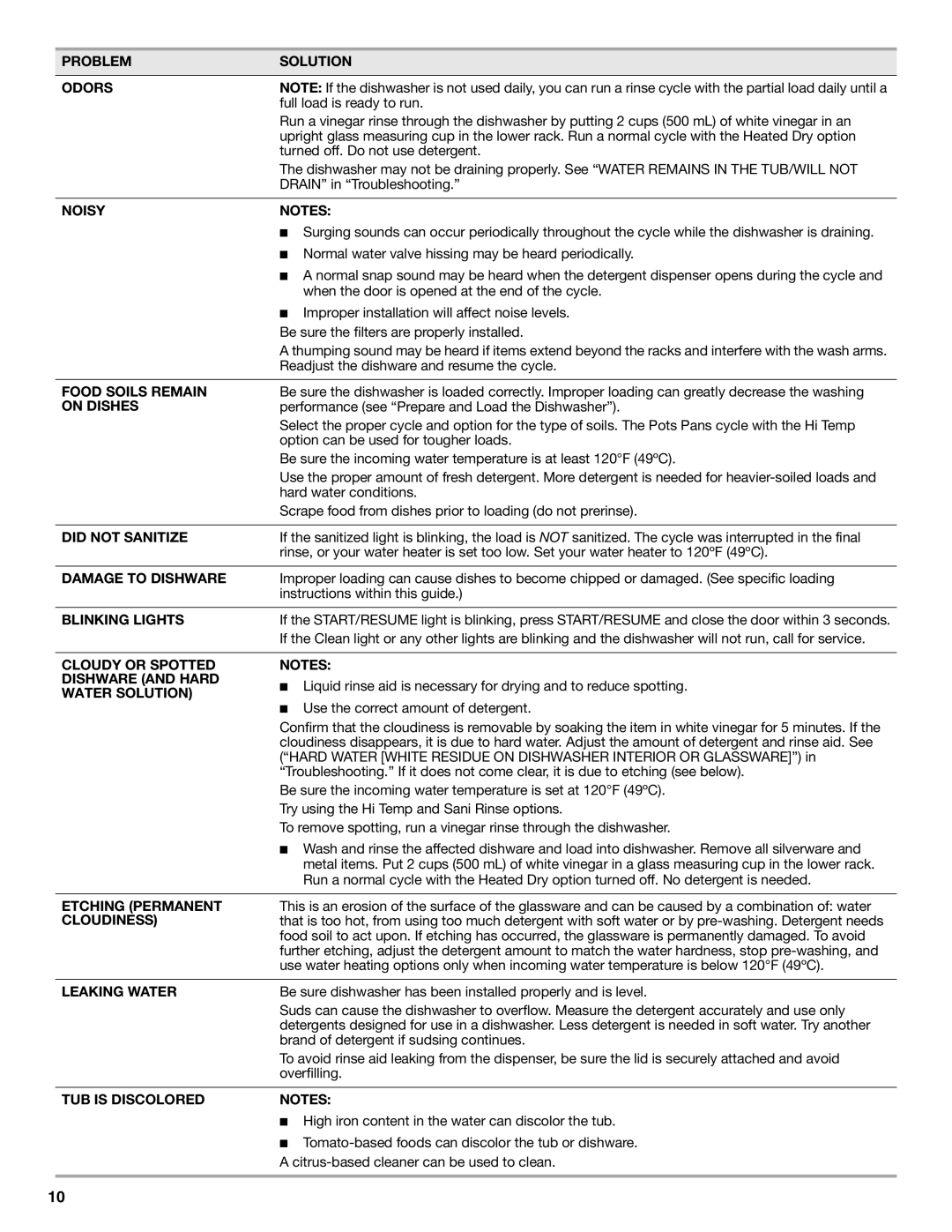
PROBLEM | SOLUTION |
|
|
ODORS | NOTE: If the dishwasher is not used daily, you can run a rinse cycle with the partial load daily until a |
| full load is ready to run. |
| Run a vinegar rinse through the dishwasher by putting 2 cups (500 mL) of white vinegar in an |
| upright glass measuring cup in the lower rack. Run a normal cycle with the Heated Dry option |
| turned off. Do not use detergent. |
| The dishwasher may not be draining properly. See “WATER REMAINS IN THE TUB/WILL NOT |
| DRAIN” in “Troubleshooting.” |
|
|
NOISY | NOTES: |
| ■ Surging sounds can occur periodically throughout the cycle while the dishwasher is draining. |
| ■ Normal water valve hissing may be heard periodically. |
| ■ A normal snap sound may be heard when the detergent dispenser opens during the cycle and |
| when the door is opened at the end of the cycle. |
| ■ Improper installation will affect noise levels. |
| Be sure the filters are properly installed. |
| A thumping sound may be heard if items extend beyond the racks and interfere with the wash arms. |
| Readjust the dishware and resume the cycle. |
|
|
FOOD SOILS REMAIN | Be sure the dishwasher is loaded correctly. Improper loading can greatly decrease the washing |
ON DISHES | performance (see “Prepare and Load the Dishwasher”). |
| Select the proper cycle and option for the type of soils. The Pots Pans cycle with the Hi Temp |
| option can be used for tougher loads. |
| Be sure the incoming water temperature is at least 120°F (49ºC). |
| Use the proper amount of fresh detergent. More detergent is needed for |
| hard water conditions. |
| Scrape food from dishes prior to loading (do not prerinse). |
|
|
DID NOT SANITIZE | If the sanitized light is blinking, the load is NOT sanitized. The cycle was interrupted in the final |
| rinse, or your water heater is set too low. Set your water heater to 120ºF (49ºC). |
|
|
DAMAGE TO DISHWARE | Improper loading can cause dishes to become chipped or damaged. (See specific loading |
| instructions within this guide.) |
|
|
BLINKING LIGHTS | If the START/RESUME light is blinking, press START/RESUME and close the door within 3 seconds. |
| If the Clean light or any other lights are blinking and the dishwasher will not run, call for service. |
CLOUDY OR SPOTTED DISHWARE (AND HARD WATER SOLUTION)
NOTES:
■Liquid rinse aid is necessary for drying and to reduce spotting.
■Use the correct amount of detergent.
Confirm that the cloudiness is removable by soaking the item in white vinegar for 5 minutes. If the cloudiness disappears, it is due to hard water. Adjust the amount of detergent and rinse aid. See (“HARD WATER [WHITE RESIDUE ON DISHWASHER INTERIOR OR GLASSWARE]”) in “Troubleshooting.” If it does not come clear, it is due to etching (see below).
Be sure the incoming water temperature is set at 120°F (49ºC). Try using the Hi Temp and Sani Rinse options.
To remove spotting, run a vinegar rinse through the dishwasher.
| ■ Wash and rinse the affected dishware and load into dishwasher. Remove all silverware and |
| metal items. Put 2 cups (500 mL) of white vinegar in a glass measuring cup in the lower rack. |
| Run a normal cycle with the Heated Dry option turned off. No detergent is needed. |
|
|
ETCHING (PERMANENT | This is an erosion of the surface of the glassware and can be caused by a combination of: water |
CLOUDINESS) | that is too hot, from using too much detergent with soft water or by |
| food soil to act upon. If etching has occurred, the glassware is permanently damaged. To avoid |
| further etching, adjust the detergent amount to match the water hardness, stop |
| use water heating options only when incoming water temperature is below 120°F (49ºC). |
|
|
LEAKING WATER | Be sure dishwasher has been installed properly and is level. |
| Suds can cause the dishwasher to overflow. Measure the detergent accurately and use only |
| detergents designed for use in a dishwasher. Less detergent is needed in soft water. Try another |
| brand of detergent if sudsing continues. |
| To avoid rinse aid leaking from the dispenser, be sure the lid is securely attached and avoid |
| overfilling. |
|
|
TUB IS DISCOLORED | NOTES: |
| ■ High iron content in the water can discolor the tub. |
| ■ |
| A |
|
|
10
